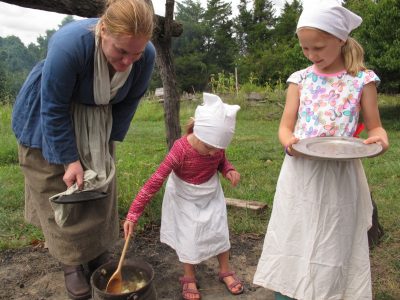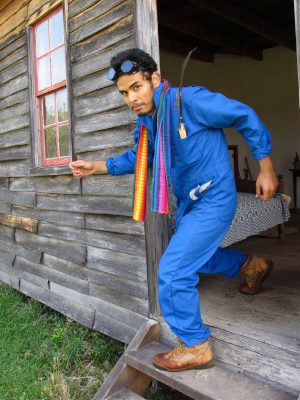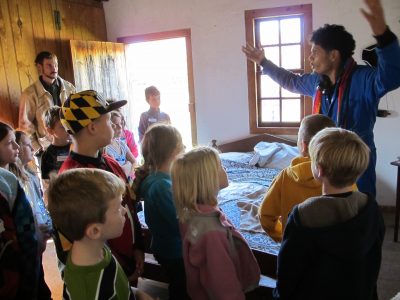History makes climate change more personal and relevant
05 December 2016 – Andrea Jones
Editor’s note: This is the first of a series of blog posts commissioned by The Public Historian on the topic of history and the interpretation of climate change in the national parks, extending the conversation on history in the national parks during this centennial year begun in its November 2016 issue.

Young visitors to the National Colonial Farm learn the colonial skill of making apple butter from bruised apples. This weekend “Green History” programming is paired with a current-day exhibit about the problem of food waste, a contributor to global warming. Photo credit: Andrea Jones
The number of Americans who deny the reality of climate change has reached an all-time low of 16 percent. While this is great news, there is still a disconnect between people’s acknowledgement of global warming and their willingness to take action to stop it. Those of us who have worked at outdoor sites or national parks find the situation particularly dire because we have first-hand appreciation for the resources that climate change threatens at an increasing rate. Sure, park visitors love the beauty of a natural setting, but how do we turn this benign appreciation into lifestyle change?
There are many ways to approach this problem. One strategy that shows promise, creating a direct connection to history, can make environmental science more personal and can be a powerful catalyst for change.
At the National Colonial Farm in Piscataway Park, I embarked on an experiment using educational programming to involve visitors in historical decision making and skill building related to environmental issues. By presenting history as a story unfolding (not calcified in a text book) and pairing history explicitly with present-day environmental issues and specific strategies, we hope to empower visitors to change the future one decision at a time. We call the initiative “Green History.” We weave the interdisciplinary past-to-present connection into weekend programs, workshops, events, and school programs.

In a theatrical role-play, time-traveler “Hank” sneakily places modern objects in 1770 to help one family escape the drudgery of colonial times. Photo credit: Andrea Jones
“Eco-Explorers: Colonial Time Warp” is one such project that takes on climate change using history. Our theatrical role-playing program (designed for grades 2–12) makes use of the colonial farm as a set for a story about an environmental crisis. In our hypothetical scenario, a character named Hank from an organization called History Helpers has gone back in time to 1770 to help one family escape the drudgery of colonial life.
Hank has placed modern items (toilet paper, pesticide, a plastic lighter, etc.) around the farm to make their lives easier. There’s just one problem. Each of these items has an environmental impact that will set in motion effects that could harm the earth sooner than expected. The Eco-Explorers–the students–must travel back to 1770 to find the items and weigh their relative convenience with environmental impact. The future is in their hands. The decision to confiscate the items and bring them back to the present is all theirs.
During a key part of the program, the Eco-Explorers accidentally catch Hank red-handed as he is placing a self-generating flashlight in the colonial house. The students force him to explain what he is doing and why he is doing it:
You know the worst thing about living back in the Dark Ages? See the light coming through those windows? And those candles over there? That’s the only light the Boltons have, poor souls. Zero electricity. No internet, no cell phones. It’s really sad actually.
He explains his solution–the hand-cranking flashlight–and says that he hopes the family cracks open the case to find out how electricity works. “It could really change their lives,” he says. The Eco-Explorer captain (played by a staff interpreter) counters that once the family discovers all the uses for electricity they will probably want to find an easier way to make it than cranking a generator. Today, almost half of electricity is generated by burning coal, creating the carbon dioxide that is making the planet hotter and hotter. Hank moves on to his next point–electricity can save lives (with Doppler radar, heart defibrillators, etc.). Besides, there is no guarantee that this family will start a coal-burning revolution. History could play out differently this time. They could adopt wind power or hydropower instead of using coal.

Hank makes the case for giving a flashlight to the colonial family. Photo credit: Andrea Jones
This exchange goes back and forth, and students participate in the debate. Our aim is to reveal that history should be looked at as a series of millions of decisions made every day by all of us. This is a hypothetical scenario, but at the end of the program we emphasize to the students there is truth in the simulation. History unfolds each day, and we each have the power to change the future. We also believe it is important to arm the students with realistic strategies. While we can’t return to colonial times, we can reduce electricity use, use energy-smart appliances, and even advocate for greener energy generation by utility companies.
Do we know if the Green History approach has an effect on actual life decisions beyond the confines of the site? Without conducting an extensive long-term evaluation we can’t be sure. We do know that our approach is supported by research in environmental psychology–the study of the relationship between human behavior and the environment. Dr. Renee Lertzman has written extensively about why human behavior does not change despite knowing about environmental problems such as climate change. Her research shows that while people understand the issues, they feel overwhelmed with the enormity of the problems and, consequently, feel powerless to act.
Programs such as Eco-Explorers aim to deconstruct and demystify overwhelming environmental problems by revealing that:
- Things haven’t always been this way, so change is possible.
- Human decisions have created our trajectory, thus, human decisions can determine our future. The course of history is not inevitable—as it is often represented in textbooks. We each have power.
- Although there is no ONE correct path, we can all learn concrete skills that can make a difference.
According to a recent study by the Nature Conservancy, young people between the ages of thirteen and eighteen who have had a personal experience in nature are more likely to “agree that we can solve climate change by acting now.” They are also more likely to express concern about water pollution, air pollution and global warming. Getting kids outdoors is a good first step.
Fueled by centennial momentum and government-funded grants, the National Park Service (NPS) has improved the accessibility of its parks, especially to young people. Bussing fourth-graders to parks by the thousands and calling for every American to “Find Your Park,” the NPS is betting on exposure as the antidote.
But is exposure to nature alone enough? And does experience in the outdoors cause concern, or is it merely correlated? Working in a park, I have had plenty of contact with people who love to spend time in nature, but do not see a connection between conserving the beautiful resources that they enjoy and their personal habits at home.
We must make climate change and other environmental problems more visible, more personal, and more relevant to visitors’ real lives. Just like the eco-problems we’re trying to solve, there is no single way to inspire people to work actively against climate change, but creating empowering programs that use history as a backdrop is one method that has brought a fresh and invigorating perspective to our site.
~ Andrea Jones served as the director of programs and visitor engagement at the Accokeek Foundation where she created the Green History approach to programming. She is now an independent consultant and founder of the Peak Experience Lab, which helps museums create transformative learning experiences.
The National Colonial Farm is a small historic site situated within Piscataway Park along the Potomac River in Maryland. It is operated by NPS partner Accokeek Foundation. In 2016, “Eco-Explorers: Colonial Time Warp” won the American Alliance for Museums’s EdCom Award for Innovation in Museum Education.
Sources and Further Reading
Sarah Sutton, Environmental Sustainability at Historic Sites and Museums (Lanham: Rowman and Littlefield & AASLH, 2015).



